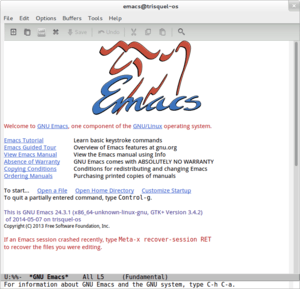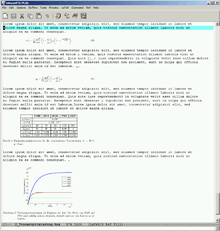GNU Emacs
|
| |
|
GNU Emacs 24.3.1 on GNOME 3 | |
| Original author(s) | Richard Stallman and Guy L. Steele, Jr. |
|---|---|
| Developer(s) | GNU Project |
| Initial release | 20 March 1985 |
| Stable release |
25.1
/ 17 September 2016 |
| Preview release |
25.1-RC2
/ 22 August 2016 |
| Repository |
git |
| Written in | C, Emacs Lisp |
| Operating system | Cross-platform to GNU, Linux, Windows, OS X, BSDs and more |
| Available in | English |
| Type | Text editor |
| License | GNU GPLv3 |
| Website |
www |
GNU Emacs is the most popular and most ported Emacs text editor. It was created by GNU Project founder Richard Stallman. In common with other varieties of Emacs, GNU Emacs is extensible using a Turing complete programming language. GNU Emacs has been called "the most powerful text editor available today."[1] With proper support from the underlying system, GNU Emacs is able to display files in multiple character sets, and has been able to simultaneously display most human languages since at least 1999.[2] Throughout its history, GNU Emacs has been a central component of the GNU project, and a flagship of the free software movement.[3][4] GNU Emacs is sometimes abbreviated as GNUMACS, especially to differentiate it from other EMACS variants.[5] The tag line for GNU Emacs is "the extensible self-documenting text editor".[6]
History

In 1976, Stallman wrote the first Emacs (“Editor MACroS”), and in 1984, began work on GNU Emacs, to produce a free software alternative to the proprietary Gosling Emacs. GNU Emacs was initially based on Gosling Emacs, but Stallman's replacement of its Mocklisp interpreter with a true Lisp interpreter required that nearly all of its code be rewritten. This became the first program released by the nascent GNU Project. GNU Emacs is written in C and provides Emacs Lisp, also implemented in C, as an extension language. Version 13, the first public release, was made on March 20, 1985. The first widely distributed version of GNU Emacs was version 15.34, released later in 1985. Early versions of GNU Emacs were numbered as "1.x.x," with the initial digit denoting the version of the C core. The "1" was dropped after version 1.12 as it was thought that the major number would never change, and thus the major version skipped from "1" to "13". A new third version number was added to represent changes made by user sites.[7] In the current numbering scheme, a number with two components signifies a release version, with development versions having three components.[8]
GNU Emacs was later ported to Unix. It offered more features than Gosling Emacs, in particular a full-featured Lisp as its extension language, and soon replaced Gosling Emacs as the de facto Unix Emacs editor. Markus Hess exploited a security flaw in GNU Emacs' email subsystem in his 1986 cracking spree, in which he gained superuser access to Unix computers.[9]
Although users commonly submitted patches and Elisp code to the net.emacs newsgroup, participation in GNU Emacs development was relatively restricted until 1999, and was used as an example of the "Cathedral" development style in The Cathedral and the Bazaar. The project has since adopted a public development mailing list and anonymous CVS access. Development took place in a single CVS trunk until 2008, and today uses the Git[10] DVCS.
Richard Stallman has remained the principal maintainer of GNU Emacs, but he has stepped back from the role at times. Stefan Monnier and Chong Yidong have overseen maintenance since 2008.[11] On September 21, 2015 Monnier announced that he would be stepping down as maintainer effective with the feature freeze of Emacs 25.[12] Longtime contributor John Wiegley was announced as the new maintainer on November 5, 2015[13]
Licensing
The terms of the GNU General Public License (GPL) state that the Emacs source code, including both the C and Emacs Lisp components, are freely available for examination, modification, and redistribution.
Older versions of the GNU Emacs documentation appeared under an ad-hoc license that required the inclusion of certain text in any modified copy. In the GNU Emacs user's manual, for example, this included instructions for obtaining GNU Emacs and Richard Stallman's essay The GNU Manifesto. The XEmacs manuals, which were inherited from older GNU Emacs manuals when the fork occurred, have the same license. Newer versions of the documentation use the GNU Free Documentation License with "invariant sections" that require the inclusion of the same documents and that the manuals proclaim themselves as GNU Manuals.
For GNU Emacs, like many other GNU packages, it remains policy to accept significant code contributions only if the copyright holder executes a suitable disclaimer or assignment of their copyright interest to the Free Software Foundation. Bug fixes and minor code contributions of fewer than 10 lines are exempt. This policy is in place so that the FSF can defend the software in court if its copyleft license is violated.
In 2011 it was noticed that GNU Emacs had been violating the GPL for two years.[14][15][16] Richard Stallman described this incident as "a very bad mistake",[17] which was promptly fixed.
Using GNU Emacs

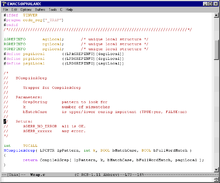
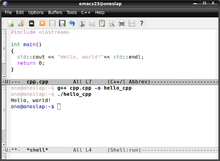
Commands
In its normal editing mode, GNU Emacs behaves like other text editors and allows the user to insert characters with the corresponding keys and to move the editing point with the arrow keys. Escape key sequences or pressing the control key and/or the meta key, alt key or super keys in conjunction with a regular key produces modified keystrokes that invoke functions from the Emacs Lisp environment. Commands such as save-buffer and save-buffers-kill-emacs combine multiple modified keystrokes.
Some GNU Emacs commands work by invoking an external program, such as ispell for spell-checking or GNU Compiler Collection (gcc) for program compilation, parsing the program's output, and displaying the result in GNU Emacs. Emacs also supports "inferior processes"—long-lived processes that interact with an Emacs buffer. This is used to implement shell-mode, running a Unix shell as inferior process, as well as REPL modes for various programming languages. Emacs' support for external processes makes it an attractive environment for interactive programming along the lines of Interlisp or Smalltalk.[18]
Users who prefer IBM Common User Access-style keys can use cua-mode, a package that originally was a third-party add-on but has been included in GNU Emacs since version 22.
Minibuffer
Emacs uses the "minibuffer," normally the bottommost line, to present status and request information—the functions that would typically be performed by dialog boxes in most GUIs. The minibuffer holds information such as text to target in a search or the name of a file to read or save. When applicable, command line completion is available using the tab and space keys.
File management and display
Emacs keeps text in data structures known as buffers. Buffers may or may not be displayed onscreen, and all buffer features are accessible to an Emacs Lisp program and to the user interface.[19] The user can create new buffers and dismiss unwanted ones, and several buffers can exist at the same time. There is no upper limit on the number of buffers Emacs allows, other than hardware memory limits. Advanced users may amass hundreds of open buffers of various types relating to their current work.[20]
Some buffers contain text loaded from text files, which the user can edit and save back to permanent storage. These buffers are said to be "visiting" files. Buffers also serve to display other data, such as the output of Emacs commands, dired directory listings, documentation strings displayed by the "help" library and notification messages that in other editors would be displayed in a dialog box. These notifications are displayed briefly in the minubuffer, and GNU Emacs provides a *Messages* buffer that keeps a history of the most recent notifications of this type. Buffers can also serve as input and output areas for an external process such as a shell or REPL. Buffers which Emacs creates on its own are typically named with asterisks on each end, to distinguish from user buffers. The list of open buffers is itself displayed in this type of buffer.
Most Emacs key sequences remain functional in any buffer. For example, the standard Ctrl-s isearch function can be used to search filenames in dired buffers, and the file list can be saved to a text file just as any other buffer. dired buffers can be switched to a writable mode, in which filenames and attributes can be edited textually; when the buffer is saved, the changes are written to the filesystem. This allows multiple files to be renamed using the search and replace features of Emacs. When so equipped, Emacs displays image files in buffers. Emacs is binary safe and 8-bit clean.[21]
Emacs can split the editing area into separate sections called "windows," a feature that has been available since 1975, predating the graphical user interface in common use. In Emacs terminology, "Windows" are similar to what other systems call "frames" or "panes" - a rectangular portion of the program's display that can be updated and interacted with independently. Each Emacs window has a status bar called the "mode line" displayed by default at the bottom edge of the window. Emacs windows are available both in text-terminal and graphical modes and allow more than one buffer, or several parts of a buffer, to be displayed at once. Common applications are to display a dired buffer along with the contents of files in the current directory (there are special modes to make the file buffer follow the file highlighted in dired), to display the source code of a program in one window while another displays a shell buffer with the results of compiling the program, to run a debugger along with a shell buffer running the program, to work on code while displaying a man page or other documentation (possibly loaded over the World Wide Web using one of Emacs' built-in web browsers) or simply to display multiple files for editing at once such as a header along with its implementation file for C-based languages. In addition, there is follow-mode, a minor mode that chains windows to display non-overlapping portions of a buffer. Using follow-mode, a single file can be displayed in multiple side-by-side windows that update appropriately when scrolled. Emacs windows are tiled and cannot appear "above" or "below" their companions. Emacs can launch multiple "frames", which are displayed as individual windows in a graphical environment. On a text terminal, multiple frames are displayed stacked filling the entire terminal, and can be switched using the standard Emacs commands.[22]
Major modes
GNU Emacs can edit a variety of different types of text and adapts its behavior by entering add-on modes called "major modes." Defined major modes exist for many different file types including ordinary text files, the source code of many programming languages, HTML documents, and TeX and LaTeX documents. Each major mode involves an Emacs Lisp program that extends the editor to behave more conveniently for the specified type of text. Major modes typically provide some or all of the following common features:
- Syntax highlighting ("font lock"): combinations of fonts and colors, termed "faces,"[23] that differentiate between document elements such as keywords and comments.
- Automatic indentation to maintain consistent formatting within a file.
- The automatic insertion of elements required by the structure of the document, such as spaces, newlines, and parentheses.
- Special editing commands, such as commands to jump to the beginning or the end of a function while editing a programming file or commands to validate documents or insert closing tags while working with markup languages such as XML.
Minor modes
The use of "minor modes" enables further customization. A GNU Emacs editing buffer can use only one major mode at a time, but multiple minor modes can operate simultaneously. These may operate directly on documents, as in the way the major mode for the C programming language defines a separate minor mode for each of its popular indent styles, or they may alter the editing environment. Examples of the latter include a mode that adds the ability to undo changes to the window configuration and one that performs on-the-fly syntax checking. There is also a minor mode that allows multiple major modes to be used in a single file, for convenience when editing a document in which multiple programming languages are embedded.
"Batch mode"
GNU Emacs supports the capability to use it as an interpreter for the Emacs Lisp language without displaying the text editor user interface. In batch mode, user configuration is not loaded and the terminal interrupt characters C-c and C-z will have their usual effect of exiting the program or suspending execution instead of invoking Emacs keybindings. GNU Emacs has command line options to specify either a file to load and execute, or an Emacs Lisp function may be passed in from the command line. Emacs will start up, execute the passed-in file or function, print the results, then exit.[24] The shebang line #!/usr/bin/emacs --script allows the creation of standalone scripts in Emacs Lisp.[25]
Batch mode is not an Emacs mode per se, but describes an alternate execution mode for the Emacs program.
Manuals
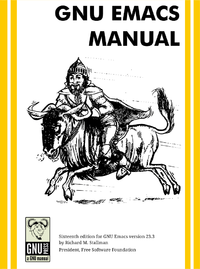
Apart from the built-in documentation, GNU Emacs has an unusually long and detailed manual. An electronic copy of the GNU Emacs Manual, written by Richard Stallman, is bundled with GNU Emacs and can be viewed with the built-in info browser. Two additional manuals, the Emacs Lisp Reference Manual by Bil Lewis, Richard Stallman, and Dan Laliberte and An Introduction to Programming in Emacs Lisp by Robert Chassell, are included. All three manuals are also published in book form by the Free Software Foundation. The XEmacs manual is similar to the GNU Emacs Manual, from which it forked at the same time that the XEmacs software forked from GNU Emacs.
Internationalization
GNU Emacs has support for many alphabets, scripts, writing systems, and cultural conventions and provides spell-checking for many languages by calling external programs such as ispell. Version 24 added support for bidirectional text and left-to-right and right-to-left writing direction for languages such as Arabic, Persian and Hebrew.
Many character encoding systems, including UTF-8, are supported. GNU Emacs uses UTF-8 for its encoding as of GNU 23, while prior versions used their own encoding internally and performed conversion upon load and save. The internal encoding used by XEmacs is similar to that of GNU Emacs but differs in details.
The GNU Emacs user interface originated in English and, with the exception of the beginners' tutorial, has not been translated into any other language.
A subsystem called Emacspeak enables visually impaired and blind users to control the editor through audio feedback.
Extensibility
The behavior of GNU Emacs can be modified and extended almost without limit by incorporating Emacs Lisp programs that define new commands, new buffer modes, new keymaps, add command-line options,[26] and so on. Many extensions providing user-facing functionality define a major mode (either for a new file type or to build a non-text-editing user interface); others define only commands or minor modes, or provide functions that enhance another extension.
Many extensions are bundled with the GNU Emacs installation; others used to be downloaded as loose files (the Usenet newsgroup gnu.emacs.sources was a traditional source) but there has been a development of managed packages and package download sites since version 24, with a built-in package manager (itself an extension) to download, install, and keep them up to date.
A few examples include:
- AUCTeX, tools to edit and process TeX and LaTeX documents
- Calc, a powerful RPN numerical calculator
- Calendar-mode, for keeping appointment calendars and diaries
- dired, a file manager
- Dissociated press, a Racter-like text generator
- Doctor, a psychoanalysis simulation inspired by ELIZA
- Dunnet, a text adventure
- Ediff and Emerge, for comparing and combining files interactively.
- Emacs/W3, a text-based web browser written in Emacs Lisp, primarily by William M. Perry. Emacs/W3 is part of the Sumo package for XEmacs, and the submodule for fetching a URL is currently part of the GNU Emacs CVS repository. Dave Raggett was supported by Emacs/W3 and by tkWWW while working on a successor to HTML 2 called HTML+.[27]
- ERC and rcirc and Circe, IRC clients[28]
- Emacs Speaks Statistics (ESS) modes for editing statistical languages like R and SAS
- Emacs Web Wowser (EWW), a built-in web browser
- Eshell, a command line shell written in Emacs Lisp. This allows closer integration with the Emacs environment than standard shells such as bash or PowerShell, which are also available from within Emacs.
- Exwm, an X window manager allowing X11 apps to be run in an Emacs window.[29]
- Gnus, a full-featured news client (newsreader) and email client and early evidence for Zawinski's Law
- MULtilingual Enhancement to Emacs (MULE) allows editing of text in multiple languages in a manner somewhat analogous to Unicode
- Org-mode for keeping notes, maintaining various types of lists, planning and measuring projects, and composing documents in many formats (such as PDF, HTML, or OpenDocument formats). There are static site generators using org mode, as well as an extension, Babel, allowing it to be used for literate programming.[30]
- Texinfo (Info), an online help-browser
- Planner, a personal information manager
- Simple Emacs Spreadsheet (SES), a spreadsheet
- SQL Interaction Mode, a mode for interacting with various flavours of SQL database servers.
- Superior Lisp Interaction Mode for Emacs (SLIME)[31] extends GNU Emacs into a development environment for Common Lisp. With SLIME (written in Emacs Lisp) the GNU Emacs editor communicates with a Common Lisp system (using the SWANK backend) over a special communication protocol and provides such tools as a read–eval–print loop, a data inspector and a debugger.
- Viper, a vi emulation layer;[32] also, Evil, a Vim emulation layer[33]
- View Mail (VM), another full-featured email client
- W3M, another web browser, this based and using on the w3m standalone browser.
- Wanderlust, a versatile email and news client
- Mediawiki-mode for editing pages on MediaWiki projects
- Zone, a display hack mode incorporating various text effects.
Performance
GNU Emacs often ran noticeably slower than rival text editors on the systems in which it was first implemented, because the loading and interpreting of its Lisp-based code incurs a performance overhead. Modern computers are powerful enough to run GNU Emacs without slowdowns, but versions prior to 19.29 (released in 1995) couldn't edit files larger than 8 MB. The file size limit was raised in successive versions, and 32 bit versions after GNU Emacs 23.2 can edit files up to 512 MB in size. Emacs compiled on a 64-bit machine can handle much larger buffers.[34]
Platforms
GNU Emacs has become one of the most-ported non-trivial computer programs and runs on a wide variety of operating systems, including DOS, Windows[35][36][37] and OpenVMS. Support for some "obsolete platforms was removed in Emacs 23.1", such as VMS and most Unix variants (except those based on Linux).[38] It is available for most Unix-like operating systems, such as Linux, the various BSDs, Solaris, AIX, HP-UX and OS X,[39][40] and is often included with their system installation packages. Native ports of GNU Emacs exist for Android[41] and Nokia's Maemo.[42]
GNU Emacs runs both on text terminals and in graphical user interface (GUI) environments. On Unix-like operating systems, GNU Emacs can use the X Window System to produce its GUI either directly using Athena widgets or by using a "widget toolkit" such as Motif, LessTif, or GTK+. GNU Emacs can also use the graphics systems native to OS X and Windows to provide menubars, toolbars, scrollbars and context menus conforming more closely to each platform's look and feel.
Forks
XEmacs
Lucid Emacs, based on an early version of GNU Emacs 19, was developed beginning in 1991 by Jamie Zawinski and others at Lucid Inc. One of the best-known forks in free software development occurred when the codebases of the two Emacs versions diverged and the separate development teams ceased efforts to merge them back into a single program.[43] After Lucid filed for bankruptcy, Lucid Emacs was renamed XEmacs and remains the second most popular variety of Emacs, after GNU Emacs. XEmacs development has slowed, with the most recent stable version 21.4.22 released in January 2009, while GNU Emacs has implemented many formerly XEmacs-only features. This has led some users to proclaim XEmacs' death.[44]
Other forks of GNU Emacs
Other forks, less known than XEmacs, include:
- Meadow – a Japanese version for Microsoft Windows[45]
- SXEmacs – Steve Youngs' fork of XEmacs[46]
- Aquamacs – a version which focuses on integrating with the Apple Macintosh user interface
Release history
Changes in each Emacs release are listed in a NEWS file distributed with Emacs.[47] Changes brought about by downgrading to the previous release are listed in an "Antinews" file[48]
| Version | Release date | Significant changes[49] |
|---|---|---|
| 25.1 | September 17, 2016 | Support for loading shared/dynamic libraries (modules). Validation of TLS/SSL certificates. New minor mode 'electric-quote-mode' for using curved quotes. Character folding support in isearch.el. Support for embedding native widgets inside Emacs buffers. New and improved facilities for inserting Unicode characters.[50] |
| 24.5 | April 10, 2015 | Mainly a bugfix release.[51][52] |
| 24.4 | October 20, 2014 | Support for ACLs (access control lists) and digital signatures of Emacs Lisp packages. Improved fullscreen and multi-monitor support. Support for saving and restoring the state of frames and windows. Improved menu support on text terminals. Another built-in web browser (M-x eww). A new rectangular mark mode (C-x SPC). File notification support.[53] |
| 24.3 | March 10, 2013 | Generalized variables are now in core Emacs Lisp, an update for the Common Lisp emulation library, and a new major mode for Python.[54] |
| 24.2 | August 27, 2012 | Bugfix release[55] |
| 24.1 | June 10, 2012 | Emacs Lisp Package Archive, support for native color themes, optional GTK+3, support for bi-directional input, support for lexical scoping in emacs lisp[56] |
| 23.4 | January 29, 2012 | Fixes a security flaw.[57] |
| 23.3 | March 10, 2011 | Improved functionality for using Emacs with version control systems. |
| 23.2 | May 8, 2010 | New tools for using Emacs as an IDE, including navigation across a project and automatic Makefile generation. New major mode for editing JavaScript source. In GUIs, the cursor is hidden while the user types. |
| 23.1 | July 29, 2009 | Support for anti-aliased fonts on X through Xft,[58] better Unicode support, Doc-view mode and new packages for viewing PDF and PostScript files, connection to processes through D-Bus (dbus), connection to the GNU Privacy Guard (EasyPG), nXML mode for editing XML documents, Ruby mode for editing Ruby programs, and more. Use of the Carbon GUI libraries on OS X was replaced by use of the more modern Cocoa GUI libraries. |
| 22.3 | September 5, 2008 | GTK+ toolkit support, enhanced mouse support, a new keyboard macro system, improved Unicode support, and drag-and-drop operation on X. Many new modes and packages including a graphical user interface to GDB, Python mode, the mathematical tool Calc, and the remote file editing system Tramp ("Transparent Remote (file) Access, Multiple Protocol").[59] |
| 22.2 | March 26, 2008 | New support for the Bazaar, Mercurial, Monotone, and Git version control systems. New major modes for editing CSS, Vera, Verilog, and BibTeX style files. Improved scrolling support in Image mode. |
| 22.1 | June 2, 2007 | Support for the GTK+ graphical toolkit, support for drag-and-drop on X, support for the OS X Carbon UI, org-mode version 4.67d included[60] |
| 21.1 | October 20, 2001 | Support for displaying colors and some other attributes on terminals, built-in horizontal scrolling, sound support, wheel mouse support, improved menu-bar layout, support for images, toolbar, and tooltips, Unicode support |
| 20.1 | September 17, 1997 | Multi-lingual support |
| 19.34 | August 22, 1996 | bug fix release with no user-visible changes[61] |
| 19.31 | May 25, 1996[62] | Emacs opens X11 frames by default, scroll bars on Windows 95 and NT, subprocesses on Windows 95, recover-session to recover multiple files after a crash, some doctor.el features removed to comply with the US Communications Decency Act[61] |
| 19.30 | November 24, 1995 | Multiple frame support on MS Windows, menu bar available on text terminals, pc-select package to emulate common Windows and Macintosh keybindings.[61] |
| 19.29 | June 19, 1995[63] | |
| 19.28 | November 1, 1994 | First official v19 release. Support for multiple frames using the X Windowing System; VC, a new interface for version control systems, font-lock mode, hexl mode for hexadecimal editing. |
| 19.7 | May 22, 1993 | |
| 18.59 | October 31, 1992 | |
| 18.53 | February 23, 1989 | |
| 18.52 | August 17, 1988 | spook.el a library for adding some "distract the NSA" keywords to every message you send.[64] RL counter terrorism Red Cross TWA Human to Human CIA al-Qaida Smuggling sneakers Ansar al-Islam Burst Morwenstow Sears Tower Sick HRT |
| 18.24 | October 2, 1986 | Server mode,[65]M-x disassemble, Emacs can open TCP connections, emacs -nw to open Emacs in console mode on xterms. |
| 17.36 | December 20, 1985 | Backup file version numbers |
| 16.56 | July 15, 1985 | First Emacs 16 release. Emacs-lisp-mode distinct from lisp-mode,[66] remove all code from Gosling Emacs due to copyright issues[67] |
| 15.10 | April 11, 1985 | |
| 13.0? | March 20, 1985 |
References
- ↑ ""Learning GNU Emacs, Third Edition": A Guide to the World's Most Extensible, Customizable Editor".
- ↑ "Alphabet Soup: The Internationalization of Linux, Part 1 Linux Journal March 1999".
With the availability of fonts and, where necessary, internationalized terminal emulators, Emacs can simultaneously handle most of the world's languages.
- ↑ "The Linux Programmer's Toolbox".
- ↑ "Learning GNU Emacs".
- ↑ "GNUMACS".
- ↑ "Debian - details of package Emacs in wheezy".
- ↑ "NEWS.1-17".
There is a new version numbering scheme. What used to be the first version number, which was 1, has been discarded since it does not seem that I need three levels of version number. However, a new third version number has been added to represent changes by user sites. This number will always be zero in Emacs when I distribute it; it will be incremented each time Emacs is built at another site.
- ↑ "GNU Emacs FAQ".
A version number with two components (e.g., ‘22.1’) indicates a released version; three components indicate a development version (e.g., ‘23.0.50’ is what will eventually become ‘23.1’).
- ↑ Stoll, Clifford (1988). "Stalking the wily hacker". Communications of the ACM. 31 (5): 484–497. doi:10.1145/42411.42412
- ↑ "Re: GNU EMACS". GNU. Retrieved 2014-11-16.]
- ↑ "Re: Looking for a new Emacs maintainer or team". gnu.org Mailing List. Retrieved 2008-02-23.; see also "Stallman on handing over GNU Emacs, its future and the importance of nomenclature"
- ↑ https://lists.gnu.org/archive/html/emacs-devel/2015-09/msg00849.html
- ↑ "Emacs gets new maintainer as Richard Stallman signs off".
- ↑ Brockmeier, Joe (Jul 29, 2011). "Say what? GNU Emacs violates the GPL". Network World. Retrieved 2016-01-19.
- ↑ License revoked: Applying Section 4 of the GPL and the lessons of Best Buy to Google’s Android by Edward J. Naughton (Aug 8, 2011)
- ↑ Emacs-Has-Been-Violating-the-GPL-Since-2009 on slashdot.org (2011)
- ↑ Re: Compiled files without sources???? Richard Stallman (28 Jul 2011)
- ↑ "GNU Emacs as a dynamically extensible programming environment".
- ↑ "Beautiful Architecture: Leading Thinkers Reveal the Hidden Beauty in Software Design".
- ↑ "Statistical Analysis and Data Display: An Intermediate Course with Examples in R".
- ↑ "A Tutorial Introduction to GNU Emacs".
- ↑ "Frames - GNU Emacs Manual".
However, it is still possible to create multiple “frames” on text terminals; such frames are displayed one at a time, filling the entire terminal screen
- ↑ Cameron, Debra; Rosenblatt, Bill; Raymond, Eric S. (1996). Learning GNU Emacs. In a Nutshell Series (2 ed.). O'Reilly Media, Inc. p. 533. ISBN 978-1-56592-152-8. Retrieved 2010-11-02.
A face is a font and colour combination.
- ↑ "Initial Options".
In batch mode, Emacs does not display the text being edited, and the standard terminal interrupt characters such as C-z and C-c have their usual effect. Emacs functions that normally print a message in the echo area will print to either the standard output stream (stdout) or the standard error stream (stderr) instead. (To be precise, functions like prin1, princ and print print to stdout, while message and error print to stderr.) Functions that normally read keyboard input from the minibuffer take their input from the terminal’s standard input stream (stdin) instead.
- ↑ "BatchMode".
- ↑ "Command Line Arguments".
- ↑ Connolly, Dan (28 September 1999). "HTML 2.0 Materials". World Wide Web Consortium. Retrieved 16 November 2010.
- ↑ Stallman, Richard (2007-06-03). "Emacs 22.1 released". info-gnu-emacs (Mailing list). Retrieved 2011-07-31.
- ↑ https://github.com/ch11ng/exwm/wiki
- ↑ "Babel: Introduction".
- ↑ SLIME: The Superior Lisp Interaction Mode for Emacs
- ↑ Kifer, Michael. "Emacs packages: Viper and Ediff". Michael Kifer's website. Retrieved 2012-11-15.
- ↑ "Home". Evil wiki. Gitorious. Retrieved 2012-11-15.
- ↑ "6.1 Does Emacs have problems with files larger than 8 megabytes?".
- ↑ B, Ramprasad (2005-06-24). "GNU Emacs FAQ For Windows 95/98/ME/NT/XP and 2000". Retrieved 2006-09-27.
- ↑ Borgman, Lennart (2006). "EmacsW32 Home Page". Retrieved 2006-09-27.
- ↑ "GNU Emacs on Windows". Franz Inc. 2006. Retrieved 2006-09-27.
- ↑ https://www.gnu.org/software/emacs/MACHINES
- ↑ "Carbon Emacs Package". Retrieved 2012-06-10.
- ↑ "Aquamacs is an easy-to-use, Mac-style Emacs for Mac OS X". Retrieved 2006-09-27.
- ↑ "Emacs on Android". EmacsWiki.
- ↑ "CategoryPorts". EmacsWiki.
- ↑ Stephen J., Turnbull. "XEmacs vs. GNU Emacs". Retrieved 2012-10-02.
- ↑ "XEmacs is Dead. Long Live XEmacs!".
- ↑ FrontPage - Meadow Wiki
- ↑ "SXEmacs Website". Sxemacs.org. 2009-10-11. Retrieved 2009-11-08.
- ↑ "NEWS.24.5".
GNU Emacs NEWS -- history of user-visible changes.
- ↑ "Antinews".
For those users who live backwards in time, here is information about downgrading to Emacs version 23.4. We hope you will enjoy the greater simplicity that results from the absence of many Emacs 24.5 features.
- ↑ Emacs Timeline. Jwz.org. Retrieved on 2013-07-17.
- ↑ "Emacs 25.1 released". lists.gnu.org. Retrieved 2016-09-17.
- ↑ "GNU Emacs NEWS -- history of user-visible changes.". 2015-04-10. Retrieved 2015-04-11.
- ↑ Petton, Nicolas (2015-04-10). "Emacs 24.5 released". Retrieved 2015-04-11.
- ↑ Morris, Glenn (2014-10-20). "Emacs 24.4 released". Retrieved 2014-10-22.
- ↑ Morris, Glenn (2013-03-10). "Emacs 24.3 released". Retrieved 2013-03-16.
- ↑ Yidong, Chong (2012-08-27). "Emacs release candidate 24.2". Retrieved 2012-11-11.
- ↑ Yidong, Chong (2012-06-01). "Emacs release candidate 24.1". Retrieved 2012-06-01.
- ↑ Yidong, Chong (2012-01-09). "Security flaw in EDE; new release plans". Retrieved 2012-02-23.
- ↑ "emacs-fu: emacs 23 has been released!". Emacs-fu.blogspot.com. 2009-07-28. Retrieved 2009-11-08.
- ↑ Zawodny, Jeremy (2003-12-15). "Emacs Remote Editing with Tramp". Linux Magazine. Retrieved 2010-02-01.
Tramp [...] stands for "Transparent Remote (file) Access, Multiple Protocol."
- ↑ Free Software Foundation Inc (2007). "Emacs News version 22.1". Retrieved 2013-12-29.
- 1 2 3 "NEWS.19".
- ↑ "Emacs Timeline".
- ↑ "GNUs Flashes".
- ↑ "NEWS.18".
- ↑ "NEWS.18".
Programs such as mailers that invoke "the editor" as an inferior to edit some text can now be told to use an existing Emacs process instead of creating a new editor.
- ↑ "NEWS.1-17".
- ↑ "Xemacs Internals".
Further reading
- Stallman, Richard M. (2002). GNU Emacs Manual (15th ed.). GNU Press. ISBN 1-882114-85-X.
- Stallman, Richard M. (2002). "My Lisp Experiences and the Development of GNU Emacs". Retrieved 2007-02-01.
- Chassel, Robert J. (2004). An Introduction to Programming in Emacs Lisp. GNU Press. ISBN 1-882114-56-6.
- Glickstein, Bob (April 1997). Writing GNU Emacs Extensions. O'Reilly & Associates. ISBN 1-56592-261-1.
- Cameron, Debra; Elliott, James; Loy, Marc; Raymond, Eric; Rosenblatt, Bill (December 2004). Learning GNU Emacs, 3rd Edition. O'Reilly & Associates. ISBN 0-596-00648-9.
